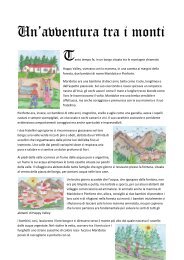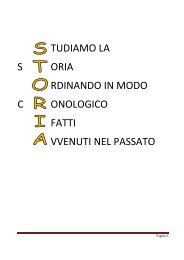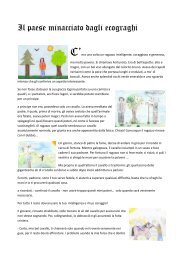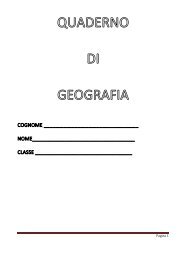quaderno di geografia3 - Giovanni.Mastrorocco.Name
quaderno di geografia3 - Giovanni.Mastrorocco.Name
quaderno di geografia3 - Giovanni.Mastrorocco.Name
Create successful ePaper yourself
Turn your PDF publications into a flip-book with our unique Google optimized e-Paper software.
Ogni parte della terra che emerge al <strong>di</strong> sopra del mare e delle pianure si chiama RILIEVO.<br />
I rilievi fino a 600 m. <strong>di</strong> altitu<strong>di</strong>ne (altezza) sul livello del mare sono chiamati COLLINE, quelli<br />
che superano i 600 m. <strong>di</strong> altitu<strong>di</strong>ne sul livello del mare sono chiamati MONTAGNE.<br />
Sulle carte geografiche “fisiche” le MONTAGNE sono rappresentate <strong>di</strong> colore Marrone.<br />
La MONTAGNA è fatta <strong>di</strong> rocce ed ogni sua parte ha un nome:<br />
La CIMA o VETTA è la parte più alta della montagna. Sulla vetta fa molto fredda anche<br />
in estate e la neve non si scioglie mai;<br />
Il PIEDE è la base della montagna;<br />
Il VERSANTE è il fianco della montagna (quello che non ve<strong>di</strong>amo);<br />
La VALLE è la zona tra due versanti opposti;<br />
Il VALICO o PASSO è la parte più bassa tra due monti o della catena montuosa che<br />
permette il passaggio da un versante all’altro;<br />
Un insieme <strong>di</strong> montagne allineato (che forma una linea) si chiama CATENA<br />
MONTUOSA;<br />
Un insieme <strong>di</strong> montagne non allineate (che hanno una forma irregolare) si chiama<br />
MASSICCIO MONTUOSO.<br />
Pagina 55








